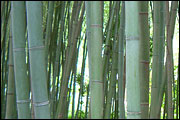 |
|
|
It's
Not How Much You Know, but How Well You Keep Learning
It is difficult to learn any style of taijiquan to any level of competence and it is even harder to keep improving in your understanding of the core principles; sometimes, despite having practised for many months or years and/or knowing many solo forms or training methods to some level of competence. Perhaps one of the main problems for modern students lies in the North American obsession with quick and superficial "progress" and "change-for-change's-sake". By contrast, true skill comes from your mental and physical understanding of the discipline in question being integrated so that your forms and methods really are upright, stable and comfortable. In the long-run, this level of skill is usually the process of years, not months. The smart practitioner learns the basics of one style from one teacher ... before then learning the more advanced methods from that same teacher ... before studying other teachers' interpretations of that same overall style ... before studying as many other martial or exercise systems available to him or her as may fill in any remaining gaps of knowledge. One of the reasons that the few real Yang style taiji experts that you may meet make almost everything that they practise and teach look like "magic" is the depth of their skill in their main art as well as the decades of experience in a variety of martial arts training and/or qigong. Oh, and many otherwise good students fail to heed their teachers' advice to practise standing qigong, even if it is only for an interim period. I resisted the notion of this kind of practise, for many years, as it is hard to see how practising physical and mental stillness could help me understand movement so I have some sympathy for modern beginners; but let me add my voice to those who say "Try it and you may understand its value." Stillness and movement really do compliment each other from both a personal and internal perspective. Here's another conundrum for the experienced practitioner: Yang taiji training without regularly practising a long solo form makes it difficult to understand the health-bringing and meditative side of that art; however, focusing on martial techniques and methods can make you a better martial artist but is liable to harm your body as you get older and does less for the spiritual side of your training. Similarly, if you don't practise a variety of applications and conditioning exercises, it is difficult to do the Yang-style as a valid martial arts. Push-hands and solo form training are only one aspect of learning the traditional fighting skills. Being sensitive and relaxed does not equate with being limp and listless in posture and attitude. Taijiquan should bring greater peace and wisdom as the years go by and part of that maturation process is the result of correct methods done correctly! However, even as one makes progress and learns to understand most, if not all of the crucial issues in their favourite art, it is always wise to periodically revisit the basics of that art. You will probably find, as I have, that it is often the small details that are the ones that bring the most benefit if you are attentive and disciplined in your training. The final step, after many years, is to simplify what one practices regularly and that applies both to the number of systems and the number of training methods and forms from each of those systems. In my experience, many modern teachers and practitioners are content to rise to a certain level of competence and then "rest on their laurels". I'm proud to say that my former senior Yang-style student, Marc Seguin, is not one of those! copyright Michael A. Babin © 2006
|
||
|
last updated on May 12, 2008 |
|
About Us | Taiji | News & Events | Articles | Resources | Contact Us |
|
